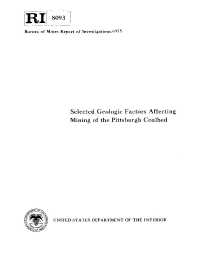Mining Publication: Selected Geologic Factors Affecting Mining of the Pittsburgh Coalbed
Original creation date: January 1975
As part of the Bureau of Mines methane control program, the Pittsburgh coalbed was studied in Washington and Greene Counties, Pennsylvania, and in Marion and Monongalia Counties, West Virginia, where this coalbed is now being mined at its greatest depth. The coalbed thickness appeared to be structurally controlled; the bed was generally thinner near the axes of anticlines and thicker near the axes of synclines. The overburden isopach shows a similar relationship. Most of the clay veins in coal occur in the synclinal troughs, generally under sandstone roof. Cleat orientations measured in 18 underground mines showed that face cleats are perpendicular to the axial trends of the folds, and the butt cleats are parallel to the axial trends, indicating structural control of the cleat. Measurement and analysis of surface joint orientations provide a method for predicting the cleat orientations of the coalbed, but linears measured from infrared photographs and photoindex sheets helped only to determine regional trends. The results of these investigations provide a geologic framework for rational planning for underground mine development to use the best available technology to cope with methane emissions, coalbed discontinuities, and related ground support problems.
Authors: CM McCulloch, WP Diamond, BM Bench, M Deul
Report of Investigations - January 1975
NIOSHTIC2 Number: 10000627
Pittsburgh, PA: U.S. Department of the Interior, Bureau of Mines, RI 8093, 1975 Jan; :1-72
See Also
- Case History of the Response of a Longwall Entry Subjected to Concentrated Horizontal Stress
- Cleat in Bituminous Coalbeds
- Methane Emissions from Four Working Places in the Beckley Mine, Raleigh County, W. Va.
- Methods of Determining the Orientations of Bedrock Fracture Systems in Southwestern Pennsylvania and Northern West Virginia
- Multiple-Seam Mining Interactions: Case Histories from the Harris No. 1 Mine
- Proceedings of the First American Conference on Human Vibration
- Removing Methane (Degasification) from the Pocahontas No. 4 Coalbed in Southern West Virginia
- Reservoir Rock Properties of Coal Measure Strata of the Lower Monongahela Group, Greene County (Southwestern Pennsylvania), from Methane Control and Production Perspectives
- Rotary Drilling Techniques Used in the Beckley Coalbed
- Use of Surface Joint and Photolinear Data for Predicting Subsurface Coal Cleat Orientation
- Content source: National Institute for Occupational Safety and Health, Mining Program


 ShareCompartir
ShareCompartir
